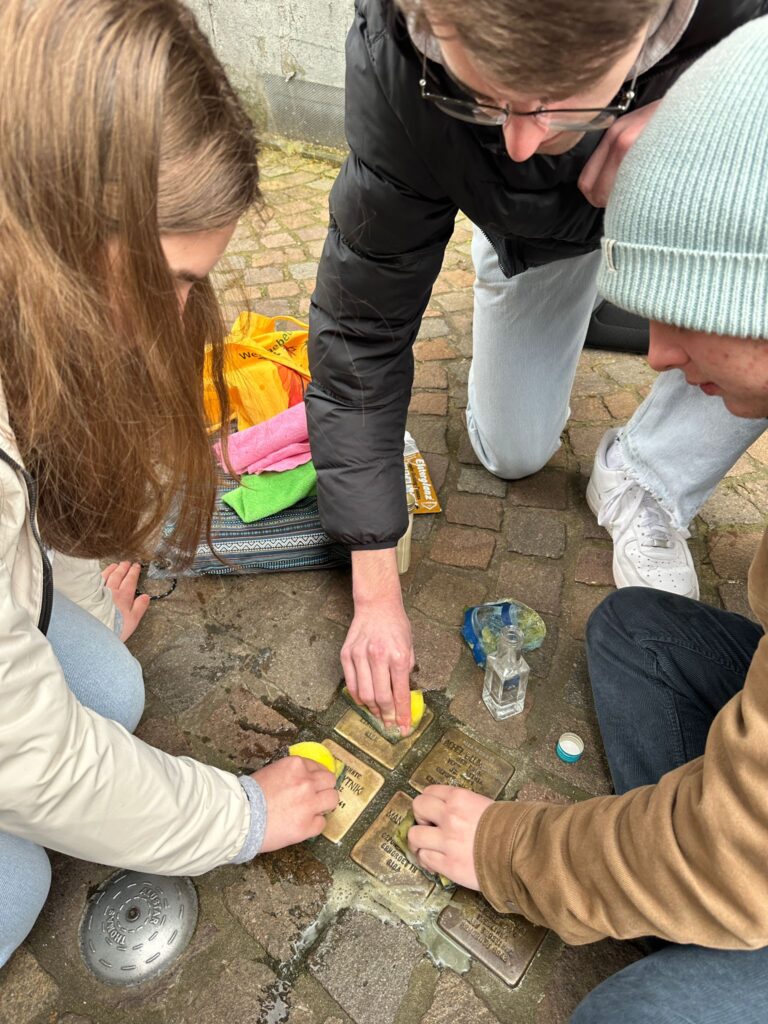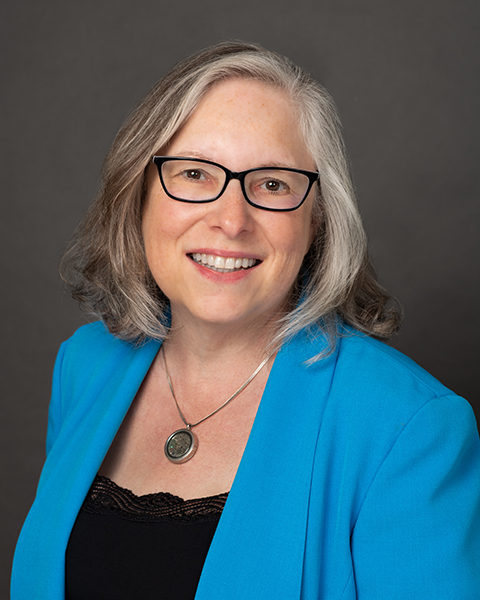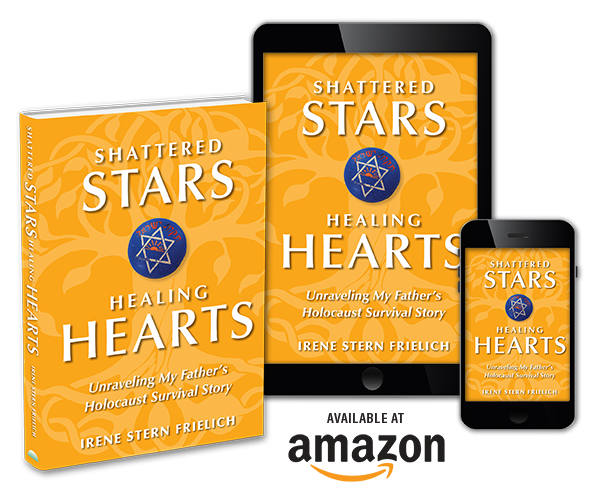Only five points. The high school junior’s response rang in my ears.
I was visiting the German language class in Canton, MA sharing my 2019 experience in my father’s hometown of Bocholt, Germany. It had been my third visit to Bocholt, this time to lay Stolpersteine in memory of my family.
Stolpersteine—literally, stumbling stones—are 3 ½ x 3 ½-inch brass-plated memorial stones placed in the ground in front of the last willful residence of someone deported or murdered during the Holocaust. Each stone is inscribed with the words “Here lived” followed by the person’s name. Birth, deportation, and death dates are also usually included. Gunter Demnig, a German resident, conceived this memorial art installation in 1993. As of May 2023, over 100,000 Stolpersteine have been placed.
Ms. Strasser, the German language teacher in Canton, had assigned each of her students the name of someone memorialized on a Stolperstein. The students were to research the person and report what they learned. I had provided the names, mostly children and young adults from Bocholt. These are the youth who, had things been different, might have attended St. Georg Gymnasium, Bocholt’s high school.
Speaking with the students in this Canton classroom was exceptionally meaningful to me. In 2018, I learned that Bocholt, Germany and Canton, MA have had an ongoing high school exchange program for over 40 years. Each fall, students from St. Georg Gymnasium in Bocholt visit Canton for three weeks and each spring Canton students visit Bocholt for three weeks. And now, I would be “introducing” the Canton students to individuals who undeniably knew my family of the 1930s.
I sat forward in my chair, eagerly anticipating each student’s report.
First were the Zytnik children: Manfred (1932-1941) and Edith (1933-1941)*. They were the children of the widow Rachel (nee Roth, 1901-1944), who married Adolf Blumenthal in 1940. The four of them, with Rachel’s mother, Marianne Roth (1868-1942), were deported to the Riga Ghetto in December 1941. That is the last known fact about the Zytnik children. I added what I had learned about my family’s relationship with them: “The morning after Kristallnacht in 1938, the children and their widowed mother joined my family in a limo that took them to the Dutch border. My family escaped across the border. The Zytnik children and their mother returned to Bocholt.” There are Stolpersteine remembering the family at Königstrasse 9 in Bocholt. (Photo above shows the Canton students polishing Stolpersteine of the Zytnik children and their family in Bocholt, Germany in April 2024.)
The longest report was about Bertold Löwenstein (1882-1942). I had provided the name of this businessman and leader of the Jewish community of Bocholt. In 1938, the Löwenstein family lived directly across the street from my family. Their daughter, Greta, witnessed my family’s home being demolished on Kristallnacht. I met Greta’s daughter a few years ago, and we shared our respective parents’ survival stories. There are Stolpersteine for Bertold and Martha (1896-1942) Löwenstein at Osterstrasse 50, the former location of their Bocholt store. A nearby square is named in their memory.
The next report was about my grandmother’s first cousin, Alice Sternberg (1921-1944). Her mother, Dina (nee Löwenstein, 1891-1942) had been born in Bocholt and married my grandmother’s uncle Max. Max and Dina lived in Plettenberg, where Max died in 1934. Alice studied nursing in Cologne. In 1938, Dina and Alice were both deported to Aachen. From there, Alice was sent to Theresienstadt in 1942, and ultimately to her death in Auschwitz in 1944. I have a postcard that Dina wrote to my family in the 1910s. Stolpersteine were placed to remember Alice and Dina at Wilhelmstrasse 24 in Plettenberg, Germany, the location of their last willful residence.
The final report was about Ruth Lorch. The Canton student provided a few facts she learned about Ruth: Ruth was born in 1923 and died in Izbica in 1942. She had moved to Bocholt with her mother shortly after her birth, and was sent away to school in Cologne from 1927-1937, when she returned to Bocholt. The student expressed her frustration: “I only found five points about her.”
“Finding five points about your person is fantastic,” I replied. “Think about it, some of these young people have no one else to remember them. You are remembering them.”
I asked the students how this research experience was for them. One shared, “I feel so much closer now. Instead of a blur of six million people, this brought it to life for me. I feel more connected.” Moved by the impact this assignment had on them, I blinked hard to prevent my tears from becoming visible to the students.
Next, I showed the video of my own family’s 2019 Stolpersteine laying ceremony in Bocholt. I explained the components of the event that dozens of Bocholters attended, including the laying of white roses and my brother’s chanting of the El Malei Rachamim prayer for the dead. We discussed the challenges of the memorial. One challenge, I explained, is that the shiny brass oxidizes to a dull color, blending in with the cobblestones that surround it. In some towns, students polish the Stolpersteine to bring back their shine. In many towns, the memorial stones are not regularly maintained.
The student who expressed frustration at finding only five points about her assigned person became excited. “I’ll be in the exchange this year, we can polish ‘our’ stones.” I could see the enthusiasm growing.
“I love that idea,” I responded. “And when someone approaches you to ask what you are doing, you can share with them those five points you learned. That’s just the right amount of information. And it’s another way you can help your person’s memory to live on.” There is a Stolperstein remembering Ruth Lorch at Ostmauer 3 in Bocholt.
On Yom HaShoah, we remember our families who were lost in the Holocaust.
And we remember those lost souls who left us something to know about them.
We also remember the blur of six million Jewish people, vanished.
But how often do we also remember someone, by name, who has no one else to remember them?
This Yom HaShoah, I will light six candles and name the youth whose memory I will keep alive:
My Uncle Kurt Herzfeld (Bocholt 1913-Auschwitz 1942).
My cousin Max Slager (Enschede 1936-Auschwitz 1944).
And Manfred Zytnik.
And Edith Zytnik.
And Alice Sternberg.
And, of course, Ruth Lorch.
Who will you remember?
*Manfred and Edith’s birth years are reversed in some records.



